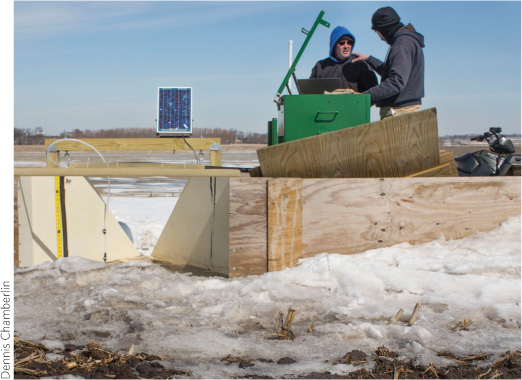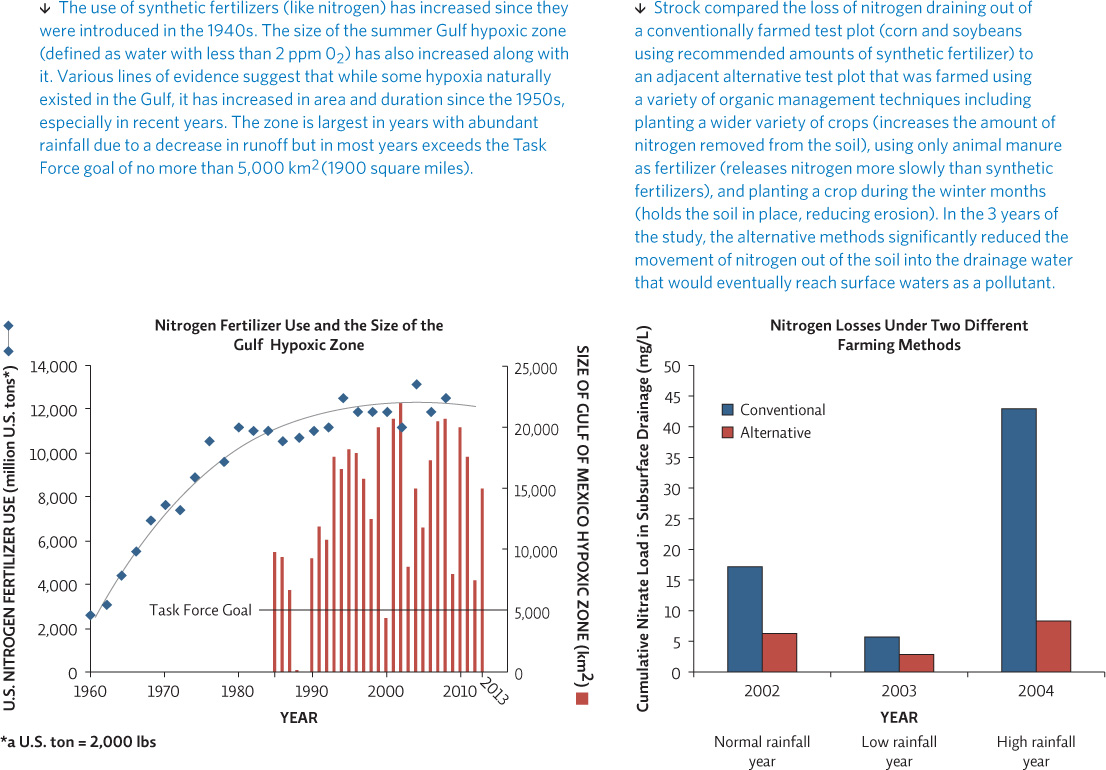Addressing eutrophication begins in the farm field.
Jeffrey Strock, a soil scientist at the University of Minnesota, is used to farmers insisting that their land would be perfect for one study or another. They want to increase crop production, or try to understand why a particular field is struggling. They come to Strock and ask for research. So at first Strock was a bit dismissive of Brian Hicks, the proprietor of Nettiewyynt Farm, who approached him at a drainage workshop in 2003. “Brian and his father wanted to try controlled drainage on their land,” Strock recalls. “They said, ‘Hey why don’t you come do some studies back on our farm? We’ve got the perfect land for it.’ And I said, ‘If I had a dime for every farmer that said that, I’d be rich.’” But a year later, Hicks approached him again. And so Strock drove by the farm and took a look. And sure enough, the land was perfect: a snowbound expanse of 1,500 acres that straddles the Cottonwood River, which feeds the Minnesota, which in turn feeds the Mississippi. The farm had been in the Hicks family since about 1886. That meant the farm’s history was well documented. And because Hicks and his father used to run cattle and had yet to convert some of their pastureland to corn and soybean, there was still virgin prairie left. That meant Strock and his team could use untouched land to install and compare two different drainage treatments.

“I had two goals,” says Hicks. “On the environmental side, I wanted to reduce the amount of nitrogen we were sending down into the river. And on the business side, I wanted to improve my crop yields.”
Strock and Hicks started by dividing one field into two zones. On the east side: conventional drainage with 4-foot-deep pipes that removed excess water from the soil at a steady rate. On the west side: controlled drainage, where the depth of the water would be made higher or lower (via a small wooden box that would serve as a dam), depending on the time of year and the needs of the crop. The hope was that the controlled drainage site would store more water—and nutrients—in the top layer of soil, which would then be available during crop production.
“As far as I know,” says Strock, “this was the very first controlled drainage project in the state of Minnesota.” By 2008, the Hicks farm had been fully instrumented, and the farmer–scientist team was ready to start taking measurements.
Here’s what they’ve found so far: during normal non-drought years, a 50% reduction in nutrient loss and a slight increase in yield (between two and five bushels—around 10%) for the controlled drainage zone compared with the conventional drainage zone. “There have been a couple occasions where conditions have been perfect and we’ve gotten a 23 bushel yield increase,” Hicks says. “Just one season with a yield like that can pay for the whole system.”
“We don’t always get the agronomic benefit [of higher crop yields],” Strock says. “But we have consistently reduced the amount of nutrients running off the field. So that environmental benefit is definitely there.”
And this environmental benefit is needed. The use of synthetic fertilizers has increased dramatically since their introduction in the mid-20th century, coinciding with the occurrence of more and bigger hypoxic regions. While direct measurements of the size of the hypoxic zone in the Gulf of Mexico have only been made since 1985, Turner and others have reported hypoxia in various regions of the Gulf since the 1970s. But researchers can also look back in time for evidence of links between hypoxia and fertilizer use; sediment core analysis shows that while some late summer hypoxia existed in the Gulf before the middle of the 20th century, it has increased in area and duration since the 1950s. (The layers of sediment cores reveal the types of organisms alive in years past—those that could tolerate hypoxic conditions and those that could not.)
Strock’s research has also shown that how one farms also makes a difference. Alternative farming techniques that focus on preventing soil erosion and increasing nutrient uptake by plants leaves less nitrogen behind in the soil to wash away. For example, a 3-year direct comparison between a conventional test plot and one farmed using organic and soil conservation techniques significantly reduced both the flow of water out of drain pipes and the amount of nitrogen in that water. INFOGRAPHIC 15.4


According to the first graph shown here, what kind of relationship is shown between nitrogen fertilizer use and the size of the Gulf of Mexico hypoxic zone?
These two variables are correlated over the long term – the size of the hypoxic zone increased over time as did the amount of nitrogen fertilizer used. The relationship is not exact, however. For example, nitrogen fertilizer use was as high in the year 2000 as it was in 2008, but the size of the hypoxic zone varied greatly. This suggests other factors influence the size of the hypoxic zone, not just the amount of nitrogen used.